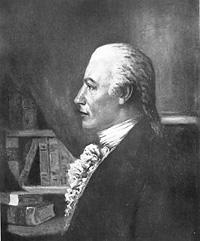George Bryan facts for kids
Quick facts for kids
George Bryan
|
|
|---|---|
 |
|
| 2nd President of Pennsylvania | |
| In office May 23, 1778 – December 1, 1778 |
|
| Vice President | Himself |
| Preceded by | Thomas Wharton |
| Succeeded by | Joseph Reed |
| 1st Vice-President of Pennsylvania | |
| In office March 6, 1777 – October 11, 1779 |
|
| Succeeded by | Matthew Smith |
| Pennsylvania Supreme Court | |
| In office April 5, 1780 – January 27, 1791 |
|
| Pennsylvania General Assembly | |
| In office ?–? |
|
| Personal details | |
| Born | 1731 Dublin, Kingdom of Ireland |
| Died | (aged 59–60) Philadelphia, Pennsylvania, U.S. |
| Resting place | Laurel Hill Cemetery, Philadelphia, Pennsylvania |
| Profession | Businessman, politician, judge |
George Bryan (1731–1791) was an important businessman and politician from Pennsylvania during the American Revolution. He was born in Ireland and later moved to Philadelphia. Bryan became the first Vice-President of Pennsylvania and then its second President, which was like being the governor. He was also a judge on the Supreme Court of Pennsylvania. A very important thing he did was to support a law that helped end slavery in Pennsylvania.
Contents
Early Life and Family
George Bryan was born in Dublin, Ireland, on August 11, 1731. His father was a merchant. In 1752, George moved to Philadelphia to start a business. He became a successful retailer and also imported and exported goods.
In 1757, George married Elizabeth Smith. They had ten children together. His son, Samuel Bryan, later became a writer who opposed the new U.S. Constitution. Around 1758, George Bryan joined the American Philosophical Society, a famous group for thinkers and scientists.
Bryan's Political Career
Early Steps in Politics
George Bryan was an active member of the Presbyterian Church. In the late 1750s and early 1760s, he tried to help solve a disagreement within his church. This experience led him to become involved in local and state politics.
When Britain passed the Stamp Act 1765 in 1765, Bryan joined other Philadelphia merchants. They signed an agreement to stop importing British goods. This action was part of the American opposition to British rule. It may have even led to his business going bankrupt in 1771.
A Leader for Independence
Bryan was seen as a "radical" because he strongly supported American independence. He was considered to be in the same group as famous figures like Thomas Paine. In the early 1770s, his health limited his political activities.
However, after Pennsylvania adopted its own Constitution in 1776, Bryan became a strong supporter of its new government structure. This included a single-house legislature and an executive council. On March 5, 1777, he was elected the first Vice-President of this Council. He officially started his term on March 6, 1777. Bryan was reelected as Vice-President on November 21, 1777.
The role of Vice-President of Pennsylvania was similar to today's Lieutenant Governor.
President of Pennsylvania
Taking the Lead
On May 23, 1778, Thomas Wharton Jr., the first President of Pennsylvania, died while in office. The state government had moved to Lancaster because the British occupied Philadelphia. According to the state's Constitution, George Bryan took over the duties of the President.
Some people consider Bryan to have been only an "Acting" President. However, the Commonwealth of Pennsylvania and the National Governors Association recognize him as a full Governor. He served from May 23, 1778, to December 1, 1778.
Under Bryan's leadership, the Council returned to Philadelphia on June 26, 1778. This was after almost nine months in Lancaster.
Later Political Roles
On December 1, 1778, Bryan ran to be formally elected President but lost to Joseph Reed. However, he was easily reelected as Vice-President. Bryan remained Vice-President for almost another year, resigning on October 11, 1779. Matthew Smith was elected to fill his place.
After serving on the Executive Council, Bryan was appointed a judge on the Supreme Court of Pennsylvania in 1780. He also served in the Pennsylvania General Assembly.
Fighting for Freedom
George Bryan was an early abolitionist. This means he believed that slavery was wrong and should be ended. He wrote the first law in history to abolish the practice. This law helped set an example for gradually ending slavery in the northern colonies.
In the late 1780s, Bryan continued to support Pennsylvania's government structure. He opposed the adoption of the 1787 Federal Constitution. He disliked it because it created a two-house legislature and a single executive leader.
University of Pennsylvania
Like many other presidents and Vice-Presidents, Bryan might have been a member of the Board of Trustees for the University of Pennsylvania just because of his office. What is certain is that after he left the Vice-Presidency in 1779, Bryan was appointed a Trustee on his own. He served on the Board until his death in 1791. He was also the Treasurer of the Board from 1779 to 1788.
Death
George Bryan died in 1791. He is buried at Laurel Hill Cemetery in Philadelphia, Pennsylvania.
See also
- List of U.S. state governors born outside the United States

